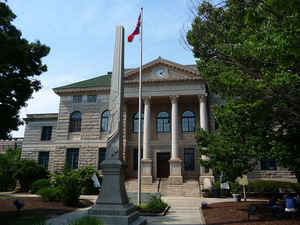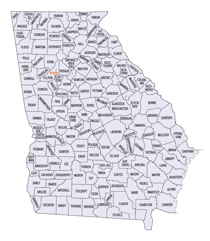Georgia Counties
Georgia is divided into one hundred and fifty-nine counties. The original eight counties of the State of Georgia were Burke, Camden, Chatham, Effingham, Glynn, Liberty, Richmond and Wilkes all created on February 5, 1777. The last new county to be established in Georgia was Peach County, established in 1924.DeKalb County, Georgia
DeKalb County Education, Geography, and History
DeKalb County is a county located in the state of Georgia. Based on the 2010 census, the
population was 691,893, making it the third-most
populous county in Georgia. DeKalb County was created
on December 9, 1822 from Henry County. The county
seat is Decatur. The county is named
in honor of "Baron" Johann DeKalb (1721-1780) a German who accompanied
the Marquis de Lafayette and was inspector general of the Colonial Army.
DeKalb County is included in the Atlanta-Sandy Springs-Roswell, GA Metropolitan Statistical Area. It contains roughly 10% of the city of
Atlanta (the other 90% lies in Fulton County). It is the most diverse county in Georgia. DeKalb is primarily a suburban county, and is the
second-most-affluent county with an African-American majority in the United States, behind Prince George's County, Maryland, in suburban
Washington D.C. and Baltimore.
Etymology - Origin of DeKalb County Name
The county is named after Baron Johann DeKalb who accompanied LaFayette to America and served as a major general in the Continental Army.
Demographics:
County QuickFacts: CensusBureau Quick Facts
DeKalb County History
DeKalb County was formed in 1822 from parts of Henry, Gwinnett, and Fayette counties. It was the 56th county created in the state and was named after Baron Johann DeKalb who accompanied LaFayette to America and served as a major general in the Continental
Army.
Decatur was incorporated December 10,1823, and named after Stephen Decatur, a US Naval hero. It is said that early residents rejected a proposal by the Western and Atlantic Railroad to make Decatur a major stop on its new line in the 1830s. These citizens did not want the noise, smoke and
confusion, and turned the railroad down. The railroad thus moved seven miles west to a small settlement called Terminus. In 1843, that settlement was renamed Marthasville, and two years later became Atlanta.
Mills and ginneries were vital to the county's early growth. This heritage lives on in the names of various DeKalb roads that once led to these mills, such as Browns Mill, Evans Mill and Henderson Mill.
The county's previous courthouse was built in 1917 at a cost of $10,000. DeKalb's present courthouse was built in 1965 at a cost of $3.5 million, while the old facility has been renovated and serves as the headquarters for the DeKalb Historical Society.
Points of Interest
Stone Mountain Park, one of Georgia's most popular tourist attractions, is located on Gwinnett's border with DeKalb County. Highlights of the 3,200-acre park include a golf course, a 363-acre lake, an antebellum plantation and a carving of Confederate heroes on the world's largest exposed mass of
granite.
The Fernbank Museum of Natural History, which opened in 1992, is said to be the largest museum of the natural sciences south of the Smithsonian in Washington D.C. Also, the Fernbank Science Center, a museum and an educational center, houses a planetarium and observatory.
Callanwode, the Tudor-style mansion, was built in 1920 as the home of Charles Howard Candler, eldest son of Coca-Cola founda Asa G. Candler. The home is listed on the National Register of Historic Places.
The heart of DeKalb County's international population is located in the International Village District within the city of Chamblee and DeKalb's International Corridor.
The collections of the Michael C. Carlos Museum of Emory University span the globe and the centuries. Housed in a distinguished building by renowned architect Michael Graves, the Carlos maintains the largest collection of ancient art in the Southeast with objects from ancient Egypt, Greece, Rome,
the Near East, and the ancient Americas. The Museum is also home to collections of 19th and 20th-century sub-Saharan African art and European and American works on paper from the Renaissance to the present.
Notable Citizens
Rebecca Latimer Felton, born near Decatur, was the first appointed woman US senator from Georgia. For several years she wrote newspaper columns that expressed her beliefs regarding women's suffrage. Following the death of Senator Tom Watson in 1922, the governor appointed Felton to the United States Senate to serve just twenty-four hours, from November 21 to 22, 1922. Felton, having served one day, served the shortest term and was the oldest Senator, at age eighty-seven, at the time of first swearing-in.
Brenda Lee, the pop singer from the 1950s and 1960s, is from Lithonia.
Geography: Land and Water
As reported by the Census Bureau, the county has a total area of 271 square miles (700 km2), of which 268 square miles (690 km2) is land
and 3.6 square miles (9.3 km2) (1.3%) is water.
Dekalb county is located in northwest Georgia. The county is crossed by the South River and numerous creeks, including Nancy Creek, Snapfinger Creek and two forks of Peachtree Creek.
Peachtree Creek and Nancy Creek drain into the Chattahoochee River and eventually to the Gulf of Mexico. South River drains into the Ocmulgee
River and ultimately into the Atlantic Ocean.
Stone Mountain lies near the eastern border of the county. Soapstone Ridge, parallel to the southern border, was heavily quarried between 1400
and 100 B.C. and objects made from the soapstone have been found as far away as the Great Lakes.
Neighboring Counties
Bordering counties are as follows:
- Northeast: Gwinnett County
- Southeast: Rockdale County
- South: Henry County
- Southwest: Clayton County
- West: Fulton County
Education
Higher Education
Emory University, Agnes Scott College, Mercer University and Georgia Perimeter College.







